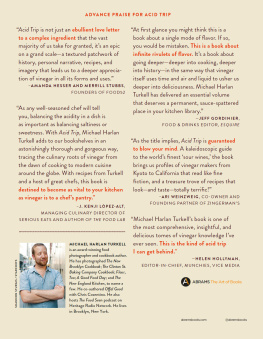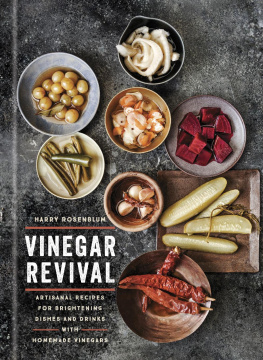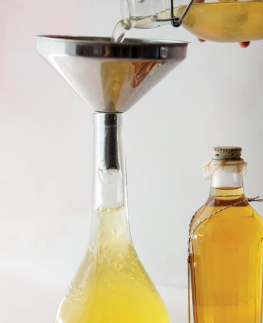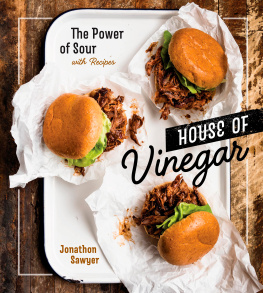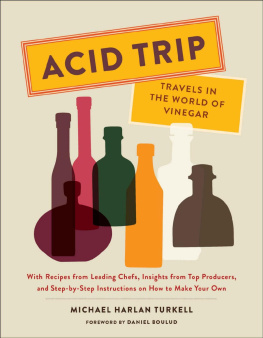

TO MDK & MASON
Editor: Michael Sand
Designer: Deb Wood
Production Manager: Alex Cameron
Library of Congress Control Number: 2016941953
ISBN: 978-4197-2417-6
eISBN: 978-1-61312-998-2
Copyright 2017 Michael Harlan Turkell
Vinegar bottle illustrations by Heesang Lee
Published in 2017 by Abrams, an imprint of ABRAMS. All rights reserved. No portion of this book may be reproduced, stored in a retrieval system, or transmitted in any form or by any means, mechanical, electronic, photocopying, recording, or otherwise, without written permission from the publisher.
Abrams books are available at special discounts when purchased in quantity for premiums and promotions as well as fundraising or educational use. Special editions can also be created to specification. For details, contact specialsales@abramsbooks.com or the address below.

ABRAMS The Art of Books
115 West 18th Street, New York, NY 10011
abramsbooks.com
CONTENTS
by Daniel Boulud

FOREWORD
BY DANIEL BOULUD
From my office, a small glass-enclosed room dubbed the skybox that sits above the kitchen at DANIEL, I notice Michael as he arrives for our meeting. He looks more like one of the farmers who often visit than a renowned professional photographerwith a scruffy beard and red flannel shirt, he stands out like a Christmas light against the starched, ultra-white uniforms of the twenty or so young chefs who make up the bustling kitchen brigade. But Michael looks quite at ease here. No outsider to the culinary world, hes been working in kitchens for the past twenty years, whether holding a camera, a knife, a notepad, or all three, and he chats comfortably with the chefs downstairs.
When he comes up to the skybox and shakes my hand, I immediately recognize him, specifically the expression of total fascination he wears at all times. One day, about ten years ago, I went to speak to my thenchef boulanger, Mark Fiorentino, and there was this kid with him (dressed similarly to the way he is today), with the aforementioned notepad and spellbound eyes, scribbling down every word Mark said, totally captivated by Marks dough-enrobed hands. At the time, Michael was studying bread, as in: bread science, bread art, bread baking, bread sales, bread production, and bread chemistry, literally the world of bread, plus some things you never knew were part of the world of bread.
I wouldnt say I dismissed him, but I was all business and needed to speak with Mark. Still, it was nice to see a young person so interested in the craft, and I wished him the best. Now, as he sits across from me with the same wide-eyed look (though perhaps hes a little under-slept), I have to say that Im as intrigued by him as he is with me, and its immediately apparent that hes found a new, unlikely muse in food, leaving planet Earth and setting up camp in the world of vinegar.
Many people might wonder what could compel someone to become obsessed with vinegar, but not me. For a chef, acidity is central to the concept of balance of flavor, and the world of vinegar, as Michael illustrates in this book, is vast and complex, much more so than many people, even chefs, realize. For me, growing up on a farm outside of Lyon, where my family made vinegar (we made for ourselves most of the things we ate), I never grasped the depth or the art of fine-tuning vinegar for flavor and sensory enjoyment. We had grapes, wine, and food to preserve, so having vinegar around was just a part of life. But later, as a chef in a wine-rich region of France, I quickly learned the distinct role that white wine vinegar vs. red wine vinegar, for example, plays in a dish, and then moved beyond to choices like tarragon vinegar, rice vinegar, balsamic vinegar, and coconut vinegarand these are very much just the basics.
At our meeting, Michael opens up his laptop to show me pictures (truly works of art) from his travels while researching the book. They include a field in Kagoshima, in the southwest of Japan, where about 52,000 tsubo (jars) are sitting outside turning into kurozu, or black vinegar. Also in Japan he captures Akihiro Iio, from Iio Jozo, maker of Fujisu rice vinegar, talking about the importance of vinegar in shari (sushi rice) made in a hangiri (wooden bowl). Another is the batteria, or series of barrels, in Acetaia San Giacomo of Reggio Emilia, Italy, one of only two regions where traditional balsamic can be made. In my home country of France, he visits Martin Pouret in Orlans, the last Orlans-style vinegar maker in an area where at least a hundred producers existed a mere hundred years ago. The expression This is not your mothers vinegar comes to mind.
Hes also brought his own vinegars for me to try: Triple Berry Vinegar, Dark Beer Vinegar, and his serendipitous Hot Toddy Vinegar. He explains how he met a vinegar maker who had recently dabbled in cocktail vinegarsmeaning vinegars to use in crafting cocktails, not vinegars flavored like popular cocktails, as Michael had first thought. So, Michael decided to take a stab at it, and created a vinegar built with ingredients such as honey, whiskey, lemon, and cloves, thus tasting like a Hot Toddy. Since, hes made a Posca Sour, a word play on an ancient Greek concoction and reminiscent of the Peruvian cocktail the pisco sour. Maybe its not the next commercial phenomenon, but it clearly has been some fun for him.
When my assistant offers coffee, Michael proudly announces hes just finished a Maple Coffee Vinegar. I tell him that would be quite the afternoon pick-me-up, and we dive into discussion of vinegar as a health remedy. This isnt news, of course, but it has trended lately as a weight-loss fad, and while the beneficial properties of vinegar are very real, Michael dismisses some of its newfound popularity. To him, its not a miracle pill to be unpleasantly gulped down in a shot glass; it is an ingredient to be savored that, when done right, is as special and exciting to him as black truffle is to me.
This idea of building vinegar is important to Michael. When he makes vinegar, he treats the potion like a living body, not just throwing liquids together and forgetting about it. Its about nurturing flavors and adjusting, sometimes on a scientific level, and sometimes on the level of pure taste. So when I try his apple vinegar, Im struck by the complex, authentic taste of apple it has, and then impressed when he confirms its made from almost a thousand pounds of wild and heirloom apple varieties. The result is no accident, its something he designed and blended with care. Vinegar can take on the flavor of almost anything, and the options for creativity are near endless, but patience is the most important ingredient.
Meeting Michael again, ten years since our first encounter, I decide that patience is one of his best assets. I dont mean to say that he is calmly twiddling his thumbs while watching wine fermentover the past ten years hes photographed at least a dozen cookbooks, been nominated for a James Beard award, contributed to countless publications, and he hosts a popular podcast called The Food Seen on Heritage Radio Networkhes a busy guy. Rather, I admire how comfortable he is with his obsession, unapologetically diving in headfirst. He gets ahold of an unsung subject in food and just accepts the fact that it will take over his life for the indefinite future.
Next page
